| Author |
Message |
|
Heather Gent
Location: Queensland, Australia Joined: 10 Sep 2003
Posts: 9
|
 Posted: Thu 11 Sep, 2003 3:50 pm Post subject: Which sword... Posted: Thu 11 Sep, 2003 3:50 pm Post subject: Which sword... |
 |
|
Dave,
The bottom few pictures in Bjorn Hellqvist's post from the Museum of Denmark... although on a second look I'm not sure now *wonders idly if I've just made an absolute goat of myself  * *
| Quote: | | I'm told that horse urine is good for softening leather, but I've never tried it. |
I can actually confirm this one.  It works on saddles, anyhow. But you need to condition the leather fairly thoroughly after that. Horse wee doesn't condition it, but it does soften it enough that you can use other preparations on it wthout making, say, any cracking worse. I have to admit I just tend to go with the preparations available commercially in preference, for some weird reason It works on saddles, anyhow. But you need to condition the leather fairly thoroughly after that. Horse wee doesn't condition it, but it does soften it enough that you can use other preparations on it wthout making, say, any cracking worse. I have to admit I just tend to go with the preparations available commercially in preference, for some weird reason  Standing under/behind a horse to collect doesn't really appeal.... hehe. Standing under/behind a horse to collect doesn't really appeal.... hehe.
I was wondering if beeswax would have been used historically, because It doesn't, you know... soak in, I combine it with turps for that for saddles, etc. Makes them a bit slippery, though, if in wrong proportion. I guess grips would be different. 
|
|
   |
 |
|
Peter Johnsson
Industry Professional
|
 Posted: Thu 11 Sep, 2003 4:31 pm Post subject: Re: Which sword... Posted: Thu 11 Sep, 2003 4:31 pm Post subject: Re: Which sword... |
 |
|
| Heather Gent wrote: | Dave,
The bottom few pictures in Bjorn Hellqvist's post from the Museum of Denmark... although on a second look I'm not sure now *wonders idly if I've just made an absolute goat of myself  * *
|
That sword is a fair bit older than the swords we call celtic today. It is one of the numerous bronze sword found in Denmark. A few of these have remaining grips, or framents of grips, that show horn or wood was used. The pommels are often missing, but remaining examples show they were shaped like beans or door knobs. Rivets and some kind of culters rezin was used to hold the grips together. It is a very strong method.
Remains of scabbards show these were made of wood or mood with fleece lining and outer cover of leather. Some scabbards had cast bronze chapes. Patterns or lines seems to have been frequently used as decoration.
To prepare leather I guess bees wax could have been used, or some animal fat. Today mink oil is very effective in waterproofing leather (it smells nice too....depending on your preferences). Leather is a good grip cover as it affords both secure purchase and adds strength to the wooden core (that surrounds the tang). Leather covered wood (with cord binding between wood and leather) is the norm for grips on medieval swords. I do not know how common it was on celtic swords. It is certainly possible, but not many grips survive today.
I add another pic of a grip on a celtic sword from the Rheinisches Landesmuseum. It is bronze, I think, made in a stacked construction. Perhaps with room for a contrasting (now lost) material between the bronze layers?
 Attachment: 45.46 KB Attachment: 45.46 KB
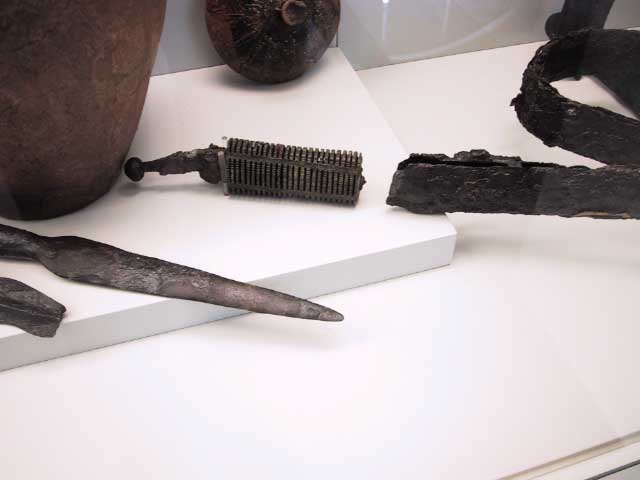
|
|
   |
 |
David White

|
 Posted: Thu 11 Sep, 2003 4:59 pm Post subject: Thickness of the bronze fittings? Posted: Thu 11 Sep, 2003 4:59 pm Post subject: Thickness of the bronze fittings? |
 |
|
Peter-
Do you have any idea of the typical thickness of the bronze fittings in the hilt, ie., pommel and guard?
Also, how were they attached to the same above?
One more question-were the fittings flush or recessed in the organic material
thanks,
dave
|
|
   |
 |
|
Peter Johnsson
Industry Professional
|
 Posted: Sun 14 Sep, 2003 4:14 am Post subject: Re: Thickness of the bronze fittings? Posted: Sun 14 Sep, 2003 4:14 am Post subject: Re: Thickness of the bronze fittings? |
 |
|
| David White wrote: | Peter-
Do you have any idea of the typical thickness of the bronze fittings in the hilt, ie., pommel and guard?
Also, how were they attached to the same above?
One more question-were the fittings flush or recessed in the organic material
thanks,
dave |
I guess you are referring to the sword from British museum with bronze hilt fittings an ribbed bronze grip, right?
The bronze details of the grip was made both by casting and by shaping bronze sheet metal. The hollow ribbed grip and the mount that sits where the guard meets the blade were cast, most probably by lost wax method. Thickness of the guard mount is around 2.5 milimeter, if I remember correctly. I could not judge the wall-thickness of the grip, but I think it is rather thinner, perhaps 1.5 milimeter.
The other bronze details are shaped from sheet metal, raised to a volume that would follow the shape of the organic material in the guard and pommel (horn or wood?). There were small holes that showed that small tacks were used to nail the ends of the mounts down. I think all these small nails are now lost, but I cannot swear on that one. It is reasonable to assume that glue or rezin was also used to hold the mounts in place and perhaps also used as a filler in the hollow grip.
It is impossible to say if the bronze was raised or sunk with surface flush to the wood or horn. I would think the latter. The cast mount at the lower end of the guard must have been counter sunk into the material of the guard as the thickness plunges below the surface of the mount at the upper end.
I think there was a wide use of cutlers rezin to help keep the various parts of the hilt together. The riveting of the tang, carefull fitting of individual parts, riveting of metal mounts and (hot setting?) rezin will combine to make a very strong and secure fit.
It may seem confusing that sword hilts were made by organic material and of many parts. Add to this tangs that seem to be fairly flimsy. Could this really have been strong enough, one might wonder?
It is a matter of choosing good quality materials (wood or horn) and shaping these to a very good fit without any gaps or weak spots. If they are held together snugly there will be plenty of strength in the material to hold up to use. The mounts of metal will also reinforce exposed ends and also add a decorative quality to the hilt. remember also that the celtic blades are light. A lighter sword can and should have a lighter tang. With less strain on the hilt you can use more delicte construction methods without fear of failiure.
The margins are smaller with less material put in use. This puts a higher demand on the skill of the craftsman: he has to know the materials he is working with, and he has to be absolutely familiar with the intended use of the sword.
|
|
   |
 |
David White

|
 Posted: Mon 15 Sep, 2003 12:08 pm Post subject: Re: Thickness of the bronze fittings? Posted: Mon 15 Sep, 2003 12:08 pm Post subject: Re: Thickness of the bronze fittings? |
 |
|
[/quote]
I guess you are referring to the sword from British museum with bronze hilt fittings an ribbed bronze grip, right?
I think there was a wide use of cutlers rezin to help keep the various parts of the hilt together. The riveting of the tang, carefull fitting of individual parts, riveting of metal mounts and (hot setting?) rezin will combine to make a very strong and secure fit.
It may seem confusing that sword hilts were made by organic material and of many parts. .[/quote]
Hi Peter-
Yes thats the one I'm asking about.
One other question, when you say "riveting of the metal mounts", are we talking about nails or actual rivets? I'm a bit
confused on this matter.
thanks,
dave
|
|
   |
 |
David McElrea

|
 Posted: Tue 16 Mar, 2004 4:30 pm Post subject: Posted: Tue 16 Mar, 2004 4:30 pm Post subject: |
 |
|
Hi all,
I lifted these from another thread where they were kindly posted by Nathan Bell.
The Lisnacrogher sword (the shorter of the swords-- top pic) is fantastic-- any educated guesses as to what the pommel would have looked like on this?
The Ballinderry sword (La Tene, not Viking  ) is also quite interesting to me, but I am wondering if anyone has a full length shot of it? (It is the double fullered sword grouped with other finds). ) is also quite interesting to me, but I am wondering if anyone has a full length shot of it? (It is the double fullered sword grouped with other finds).
Does anyone know which museum(s) these are in?
Cheers,
David
 Attachment: 11.63 KB Attachment: 11.63 KB

 Attachment: 92.23 KB Attachment: 92.23 KB

|
|
  |
 |
B. Stark
Industry Professional

|
 Posted: Tue 16 Mar, 2004 6:44 pm Post subject: Posted: Tue 16 Mar, 2004 6:44 pm Post subject: |
 |
|
WOW! First time I've seen actual photos and not line drawings of those swords ( bottom pic ). I've a keen interest in Irish swords from the first century up to the Viking era. Would love to see more work done concerning these Dark Age weapons of the "Celtic Fringe". To Peter: is this the blade your thinking of emulating ( I was just talking to Mike S. about this today ), the double fuller you mentioned? 
|
|
  |
 |
David McElrea

|
 Posted: Wed 17 Mar, 2004 4:27 am Post subject: Posted: Wed 17 Mar, 2004 4:27 am Post subject: |
 |
|
B.Stark wrote: | Quote: | | WOW! First time I've seen actual photos and not line drawings of those swords ( bottom pic ). I've a keen interest in Irish swords from the first century up to the Viking era. Would love to see more work done concerning these Dark Age weapons of the "Celtic Fringe". To Peter: is this the blade your thinking of emulating ( I was just talking to Mike S. about this today ), the double fuller you mentioned? |
Hi Mike,
I have to admit I have been wondering the same, although either of the two main swords would do for me (as long as the Lisnacrogher had a bit more length to it). Although I won't restrict myself to Irish swords, I am hoping to build up a collection that is representative of swords (and some other weapons) from the Bronze Age through to the Late Medieval. If the Albion NG La Tene fits into the Irish Iron Age bracket I will be more than satisfied (and then, of course there are the ring-hilts and the Clontarf).
Regards,
David
|
|
  |
 |
Robert Zamoida

|
 Posted: Wed 17 Mar, 2004 8:29 am Post subject: Posted: Wed 17 Mar, 2004 8:29 am Post subject: |
 |
|
| Peter Johnsson wrote: | | This is a sword from the Klingenmuseum in Solingen. It is slim and slight but have the same shape and proportions as bigger cousins of the same type. The cross section is crisp and shows some marks from forging. |
I cannot believe I missed this thread! <smacks self upside of head>
I am awed by the cross section of this sword; the one feature that really grabs me is the bevelling of the double fullers, from the medial ridge to the edge, and the way that the bevelliing produces the thick medial ridge seen in hollow ground medieval swords while at the same time providing a decent amount of mass behind the edge, lightening the overall weight of the sword and providing structural reinforcement along the flat of the blade. (Wow, what a mouthful  ). Wonderful! I truly hope that a similar blade will be incorporated into the design of the Next Gen La Tene (Although, from a financial perspective I am truly going to regret this, since the challenges in producing this type of blade combined with the use of metal/organic hilt components will probably put this sword in the $950 range ). Wonderful! I truly hope that a similar blade will be incorporated into the design of the Next Gen La Tene (Although, from a financial perspective I am truly going to regret this, since the challenges in producing this type of blade combined with the use of metal/organic hilt components will probably put this sword in the $950 range  ). ).
| Peter Johnsson wrote: | | The blades show a high degree of specialization: slim dimensions, fine and thin edges and points that can be used in slashing cuts and thrusting attacks on opponents that have none or very little in the way of armour. Quick, precise swords meant to be used by expert swordsment in single combat betewwn equals (or to be used in terrorizing unarmored civilians, of course). This is very different from trying to hack into a line of heavily armed infantry with sturdy helmets and metal reinforced shileds. |
This has really got my wheels turning! The many discussions and lessons with my Sifu demonstrate the same principles within Chinese Swordsmanship, especially when dealing the the wu-jien, or civilian sword. He is always fond of saying that when one faces a swordsman using a jian, they will not die from a single cut or thrust, but from a thousand; that would require the same quickness and precision not only in the sword, but in the techniques of the swordsman as well. Perhaps there are parallels not only in the design of Celtic swords and Chinese jian but also in the techniques as well; maybe the principles of Chinese swordsmanship, combined with whatever contemporary evidence and accounts there are could be used to as a foundation in reconstructing the sword techniques of the Celtic Warrior. 
What an awesome thread!!
Rob Zamoida
"When your life is on the line, you want to make use of all your tools. No warrior should be willing to die with his swords at his sides, without having made use of his tools."
-Miyamoto Mushashi, Gorin no Sho
|
|
  |
 |
|
Nathan Bell
|
 Posted: Wed 17 Mar, 2004 10:03 am Post subject: Posted: Wed 17 Mar, 2004 10:03 am Post subject: |
 |
|
| David McElrea wrote: | B.Stark wrote: | Quote: | | WOW! First time I've seen actual photos and not line drawings of those swords ( bottom pic ). I've a keen interest in Irish swords from the first century up to the Viking era. Would love to see more work done concerning these Dark Age weapons of the "Celtic Fringe". To Peter: is this the blade your thinking of emulating ( I was just talking to Mike S. about this today ), the double fuller you mentioned? |
Hi Mike,
I have to admit I have been wondering the same, although either of the two main swords would do for me (as long as the Lisnacrogher had a bit more length to it). Although I won't restrict myself to Irish swords, I am hoping to build up a collection that is representative of swords (and some other weapons) from the Bronze Age through to the Late Medieval. If the Albion NG La Tene fits into the Irish Iron Age bracket I will be more than satisfied (and then, of course there are the ring-hilts and the Clontarf).
Regards,
David |
Greetings Gentlemen,
I somewhat doubt that Peter is basing the double-fullered La tene sword upon either Irish example, at least with regard to blade size/proportion. These "swords" are quite small, and even the double-fullered cutter in the photo from Ryan is quite small. Although it is one of the longest Irish swords *believed* to date from the Late La Tene period, it is quite distinct from either the British examples of this period and the Continental norms. The blade length is, IIRC, a bit under 19", and the surviving fittings are a good bit different from Continental and even British "celtic" pieces. The length issue carries on the Irish tendency---from the bronze age to the early viking age, to have quite short swords. So a long. double-fullered cutting blade in late La Tene Ireland would not really fit the Irish Iron Age bracket  (at least based on the examples found so far. (at least based on the examples found so far.
No worries, though, as there are a number (though not a large number) of Continental La tene blades that evidence this double-fullered cut-emphasis structure, and have a more "typical La Tene" length.
But I find that the Irish "shorties", reconstructed in the right size brackets have a charm of their own! :
 Attachment: 32.41 KB Attachment: 32.41 KB
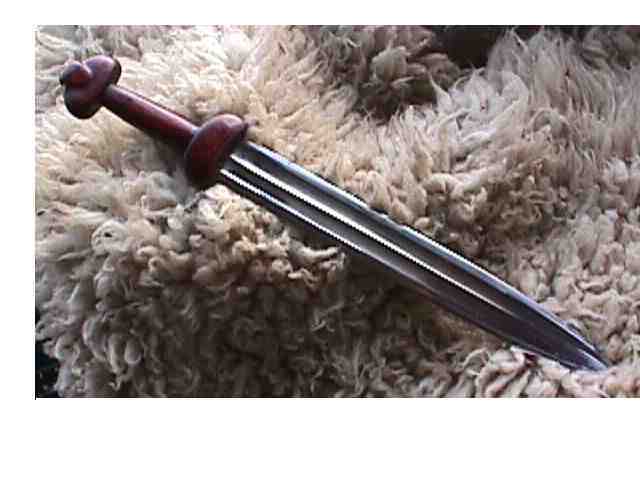
Last edited by Nathan Bell on Wed 17 Mar, 2004 4:59 pm; edited 1 time in total
|
|
   |
 |
David McElrea

|
 Posted: Wed 17 Mar, 2004 11:21 am Post subject: Posted: Wed 17 Mar, 2004 11:21 am Post subject: |
 |
|
Nathan Bell wrote: | Quote: | | But I find that the Irish "shorties", reconstructed in the right size brackets have a charm of their own! : |
You realise you can't just put a pic like that up without a bit of explanation  Is it fair to assume that this is the fruit of your ponderings and that you finally got a custom copy of the Lisnacrogher? I can't quite make out the hiltwork very clearly. Would it be possible to get a closer and brighter shot? Is it fair to assume that this is the fruit of your ponderings and that you finally got a custom copy of the Lisnacrogher? I can't quite make out the hiltwork very clearly. Would it be possible to get a closer and brighter shot?
Regards,
David
|
|
  |
 |
Robert Zamoida

|
 Posted: Wed 17 Mar, 2004 2:16 pm Post subject: Re: Celtic swords Posted: Wed 17 Mar, 2004 2:16 pm Post subject: Re: Celtic swords |
 |
|
| Peter Johnsson wrote: | | A very poor photo of a famous sword in the British museum. It is arranged incorrectly, as the pommel and guard have changed places and are turned the wrong way. I like these hollow bronze grips, though. Perhaps you can get an idea of the shape despite the poor quality of the photo : |
Hey Peter,
Is this how it should look?
 Attachment: 81.17 KB Attachment: 81.17 KB
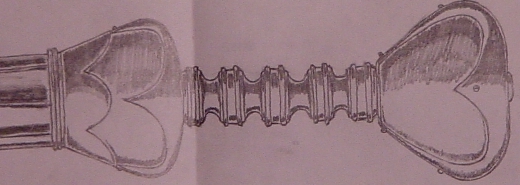
Rob Zamoida
"When your life is on the line, you want to make use of all your tools. No warrior should be willing to die with his swords at his sides, without having made use of his tools."
-Miyamoto Mushashi, Gorin no Sho
|
|
  |
 |
|
Nathan Bell
|
 Posted: Wed 17 Mar, 2004 4:57 pm Post subject: Posted: Wed 17 Mar, 2004 4:57 pm Post subject: |
 |
|
| David McElrea wrote: | Nathan Bell wrote: | Quote: | | But I find that the Irish "shorties", reconstructed in the right size brackets have a charm of their own! : |
You realise you can't just put a pic like that up without a bit of explanation  Is it fair to assume that this is the fruit of your ponderings and that you finally got a custom copy of the Lisnacrogher? I can't quite make out the hiltwork very clearly. Would it be possible to get a closer and brighter shot? Is it fair to assume that this is the fruit of your ponderings and that you finally got a custom copy of the Lisnacrogher? I can't quite make out the hiltwork very clearly. Would it be possible to get a closer and brighter shot?
Regards,
David |
No this is not my idea of the custom Lisnacrogher(just haven't gotten the right smith committed yet). It's a much more simplified blade. This one was made for me by Irish Arms, though I think that Paul Binns, from your side of the pond, did the blade. The hilt is simply carved Irish oak, a fairly faithful reproduction of the wooden Ballykilmurray sword (attached). The blade has the profile of the Lisnacrogher, but the cross-section is more like the other "Balinderry" sword---double fullered as opposed to a highly raised midridge with flanking grooves.
My "dream" Lisnacrogher would have the same thicker midridge, and would be a good bit more complex, complete with the bronze spacers for the organic grip, and fully engraved bronze scabbard---I would really like to go high-end. I also believe that the proposed reconstruction of the hilt, that is seen reproduced in Rynne and so many articles is a bit off. I have an idea or two there 
The Irish Arms piece is, however, a good blade for the price, and gives a nice idea of how these would have handled, which lends to more ideas about potential fightings styles of the Irish from the BA to the Early Christian era using these wicked little short blades....
 Attachment: 20.8 KB Attachment: 20.8 KB
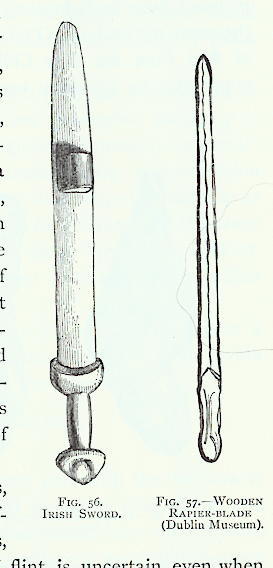
|
|
   |
 |
David McElrea

|
 Posted: Wed 17 Mar, 2004 6:02 pm Post subject: Posted: Wed 17 Mar, 2004 6:02 pm Post subject: |
 |
|
Hi Nathan, thanks for that-- I look forward to seeing your ideas made flesh (or iron, bronze, and wood as the case may be) some day.
You wrote: | Quote: | The Irish Arms piece is, however, a good blade for the price, and gives a nice idea of how these would have handled, which lends to more ideas about potential fightings styles of the Irish from the BA to the Early Christian era using these wicked little short blades....
|
While Viking weapons would have been common amongst the Irish by 1014, I have often wondered if Brian Boru's son used the traditional short Irish swords in the Battle of Clontarf. The Annals desribe Murchad (or Murrough) as fighting with a sword in each hand-- I suppose he may have had a Viking blade in one hand and an Irish in the other, or two Irish (or, for that matter two Viking blades-- who really knows?). With regard to potential fighting styles, it strikes me that two Irish blades could be used quite effectively. I wonder if Murchad's tecnique was his own or part of a tradition passed down to him.
Having said that, the Tain and other epics tend to mention spear, sword and shield. I guess the truth is bound to be elusive.
David
|
|
  |
 |
David McElrea

|
 Posted: Thu 18 Mar, 2004 3:08 pm Post subject: Posted: Thu 18 Mar, 2004 3:08 pm Post subject: |
 |
|
Nathan Bell wrote: | Quote: | | I also believe that the proposed reconstruction of the hilt, that is seen reproduced in Rynne and so many articles is a bit off. |
Nathan,
Where can one find Rynne's work? I am aware of his "Calssification of pre-viking Irish Iron Swords" but have never seen it anywhere--nor can I find anything else by him, yet he seems like someone I would enjoy reading.
| Quote: | ... which lends to more ideas about potential fightings styles of the Irish from the BA to the Early Christian era using these wicked little short blades....
|
Could you elaborate on that a bit? After having thought about it a bit I've become quite curious as to how the fighting styles may have developed around these blades. The Irish were obviousy quite happy with their fencing styles as their was no great technological revolution in sword making until the Viking Era. One could be tempted to draw on the Roman example (gladius and shield) but everything militates against that (although some have tried to draw connections between the Laigin and Romano British or Roman trained Irish warbands... don't know about that).
Where the Romans fought as units with gladius and scutum, the Irish fought in bands made up of individuals-- the heroic idealism that one finds in Homer was very much alive for the Irish. Their swords were small, and so were their shields (apparently). It seems likely, then, that the fighting styles of the Irish would have been quite different-- but having said that I cannot guess what it may have looked like.
I am assuming the Irish had likely developed their martial skills into an art form given both their propensity for warfare and the lack of development seen in their swords (rather than the opposite assumption-- that they simply brawled with pointy objects in hand). Any ideas would be of great interest.
Cheers once again,
David
|
|
  |
 |
|
Nathan Bell
|
 Posted: Fri 19 Mar, 2004 6:28 am Post subject: Re: Celtic swords Posted: Fri 19 Mar, 2004 6:28 am Post subject: Re: Celtic swords |
 |
|
| Robert Zamoida wrote: | | Peter Johnsson wrote: | | A very poor photo of a famous sword in the British museum. It is arranged incorrectly, as the pommel and guard have changed places and are turned the wrong way. I like these hollow bronze grips, though. Perhaps you can get an idea of the shape despite the poor quality of the photo : |
Hey Peter,
Is this how it should look? |
Hi Robert,
I'm not Peter, and I am certainly a poor substitute for him, but I can hazard a guess here, since Peter appears to be unable to post on this thread currently...(see Off topic forum)
I would wager that yes, this is the configuration, very nearly, that Peter had envisioned. I can see it that way as well. Note that this makes the hilt congruent/convergent with its contemporary, the Hod Hill(attached) hilt, and also with the slightly later(?) "crown hilt" swords.
For my own notes, FWIW
I tend to think of the Hod Hill and Cotterdale swords as not really "celtic" but Romano-British. I feel that this puts the proper emphasis in place. The hilts are for all pruposes Roman hilts in their basic elements: large bulbous spheroid/rounded pommel, columnar grip with some form of lateral finger ridging, hemi-spheroid guard area with straight shoulders. The "British" element really only comes in in re-decorating the hilt and giving it flair (and also, of course, in the scabbard). These swords are less a direct amalgamation of the styles (like the Embleton and Thorpe) and more a "makeover" of existing Roman hilt features.
Kind of like a "British eye for the Roman guy" if you will 
 Attachment: 14.12 KB Attachment: 14.12 KB
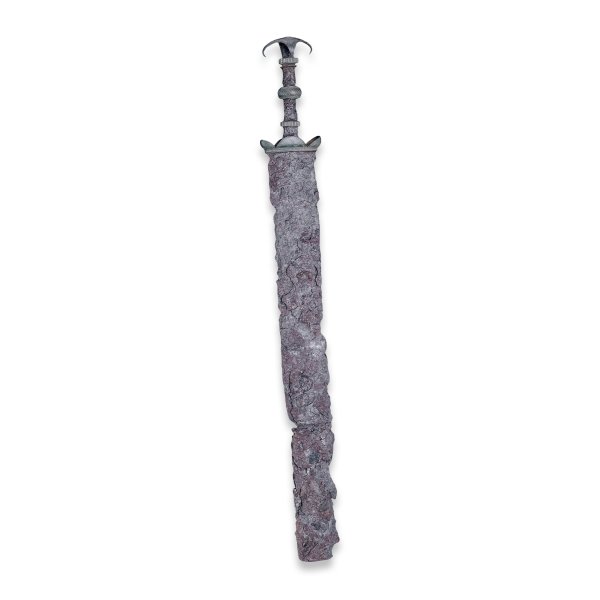
|
|
   |
 |
|
Nathan Bell
|
 Posted: Fri 19 Mar, 2004 6:44 am Post subject: Posted: Fri 19 Mar, 2004 6:44 am Post subject: |
 |
|
| David McElrea wrote: |
Nathan,
Where can one find Rynne's work? I am aware of his "Calssification of pre-viking Irish Iron Swords" but have never seen it anywhere--nor can I find anything else by him, yet he seems like someone I would enjoy reading. |
Hi David,
I have the Rynne article in a slim volume of collected articles : Studies on Early Ireland, essays in honour of M.V. Duignan (ed. B.G. Scott). It's out of print and I bought it online at a bit of expense, but it was worth it to me, at least. Perhaps Inter-Library loan would work out for you better? It has the brief Rynne article, nice but short, scholarly, but I think perhaps too conclusory in spots? Also in the pamphlet is a great article "The Sword of the Ulster Cycle" by J.P. Mallory---sounds just up your alley, perhaps Mr. Stark's as well?
Rynne also has an article in "From the Stone Age to the '45" on the characteristic Irish and north Scots organic late La Tene/Early Iron Age pommels, which is nice. (Again, I find him a bit too hasty and conclusory in small parts, but very nice overall).
| Quote: |
Could you elaborate on that a bit? After having thought about it a bit I've become quite curious as to how the fighting styles may have developed around these blades. The Irish were obviousy quite happy with their fencing styles as their was no great technological revolution in sword making until the Viking Era. One could be tempted to draw on the Roman example (gladius and shield) but everything militates against that (although some have tried to draw connections between the Laigin and Romano British or Roman trained Irish warbands... don't know about that).
Where the Romans fought as units with gladius and scutum, the Irish fought in bands made up of individuals-- the heroic idealism that one finds in Homer was very much alive for the Irish. Their swords were small, and so were their shields (apparently). It seems likely, then, that the fighting styles of the Irish would have been quite different-- but having said that I cannot guess what it may have looked like.
I am assuming the Irish had likely developed their martial skills into an art form given both their propensity for warfare and the lack of development seen in their swords (rather than the opposite assumption-- that they simply brawled with pointy objects in hand). Any ideas would be of great interest. |
Oh man, don't know where to start here! This would best be done over a pint or so in a pub, with perhaps some "props" around to illusstarte and debate. Steve Peffley and I discussed this a good bit, and he has some great insights here, as well.
At the risk of highjacking this thread, I would just summarize and condense unmercifully to this: I think the Irish fighting had a very heavy spear emphasis, from the general character of the Ulster and Fenian cycles, and amount of time spent speaking of spear-feats and spear combat....From there, I would guess the heroic ethos would lend toward a very grappling, close-combat oriented, down-and dirty style. This would be a style that highlights personal bravery and/or disdain of the potential danger and also emphasizes difficult and specific guards and wards (i.e. feats) I rather don't see the Irish fighting in a sub-Roman pseudo legionary fashion, but rather in a seriers of very visceral, very physical short sword(dirk) and and buckler combat styles. Whew. But that is certainly my opinion only, and would be happy to carry this further, off and on--perhaps in the off-topic portion of the fora?
N
|
|
   |
 |
Kirk Lee Spencer

|
 Posted: Mon 22 Mar, 2004 8:38 am Post subject: Re: Celtic swords Posted: Mon 22 Mar, 2004 8:38 am Post subject: Re: Celtic swords |
 |
|
| Robert Zamoida wrote: | | Peter Johnsson wrote: | | A very poor photo of a famous sword in the British museum. It is arranged incorrectly, as the pommel and guard have changed places and are turned the wrong way. I like these hollow bronze grips, though. Perhaps you can get an idea of the shape despite the poor quality of the photo : |
Hey Peter,
Is this how it should look? |
Hi Robert...
Let me add my thoughts here. I think that the museum has placed the hilt components in their correct order. However the hilt should be turned 180 degrees so that the guard is next to the scabbard mouth.
There have been several celto-roman spatha type swords found that have the tear-drop pommel in this position. See the Koln Spatha here http://www.albionarmorers.com/swords/albion/kolnspatha.htm
Also an important monograph on such swords by Stuart Piggott reconstructed the sword in this way. However I guess that the experts (Piggott) could get it wrong also.
Thanks
ks
 Attachment: 88.03 KB Attachment: 88.03 KB
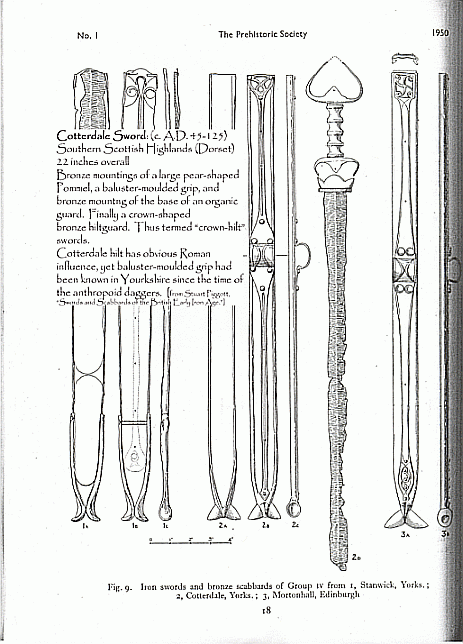
Two swords
Lit in Edenís flame
One of iron and one of ink
To place within a bloody hand
One of God or one of man
Our souls to one of
Two eternities
Last edited by Kirk Lee Spencer on Sun 09 May, 2004 8:43 pm; edited 1 time in total
|
|
  |
 |
David McElrea

|
 Posted: Mon 22 Mar, 2004 2:46 pm Post subject: Posted: Mon 22 Mar, 2004 2:46 pm Post subject: |
 |
|
Hi Nathan,
I just wanted to thank you for your great responses. I'll keep an eye out for the articles-- couldn't find them anywhere online (to buy). I suppose I may just not know where to look. Anyway, thanks again.
Yours,
David
|
|
  |
 |
David McElrea

|
 Posted: Tue 20 Apr, 2004 5:54 pm Post subject: New Scottish Sword Find Posted: Tue 20 Apr, 2004 5:54 pm Post subject: New Scottish Sword Find |
 |
|
Hi all,
Archeologists have recently discovered an Iron Age burial in Alloa, Scotland. The cyst contained the remains of a young man-- probably around thirty years old, along with a spear, shield, and sword. The sword is described as being arond 24" long, making it the longest iron age sword found in Scotland (or so the article says).
Does anyone have any more information on this sword? I've tried to hunt down some photos, but have had no success. For those who are interested, the article can be found at the bottom of this post.
Cheers,
David
http://news.scotsman.com/scotland.cfm?id=428762004
|
|
  |
 |
|
|
You cannot post new topics in this forum
You cannot reply to topics in this forum
You cannot edit your posts in this forum
You cannot delete your posts in this forum
You cannot vote in polls in this forum
You cannot attach files in this forum
You can download files in this forum
|
All contents © Copyright 2003-2024 myArmoury.com — All rights reserved
Discussion forums powered by phpBB © The phpBB Group
Switch to the Basic Low-bandwidth Version of the forum
|

